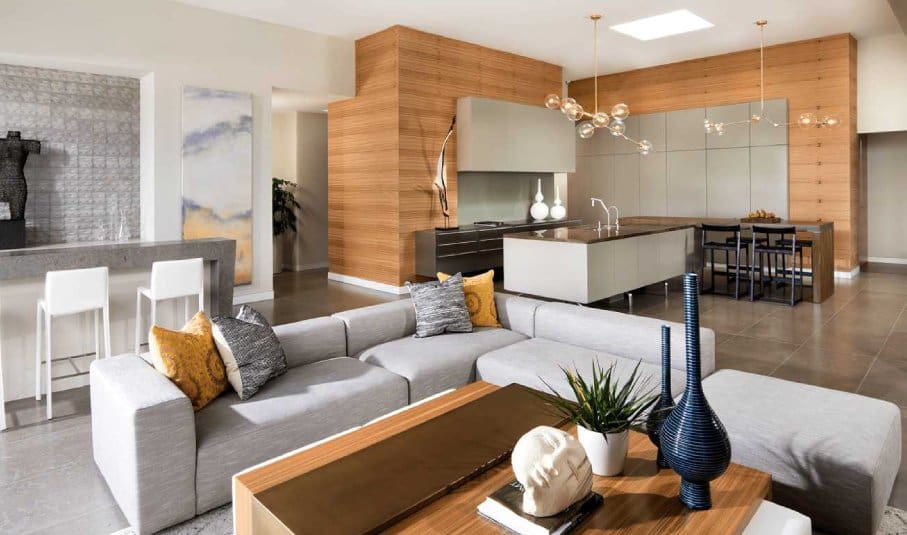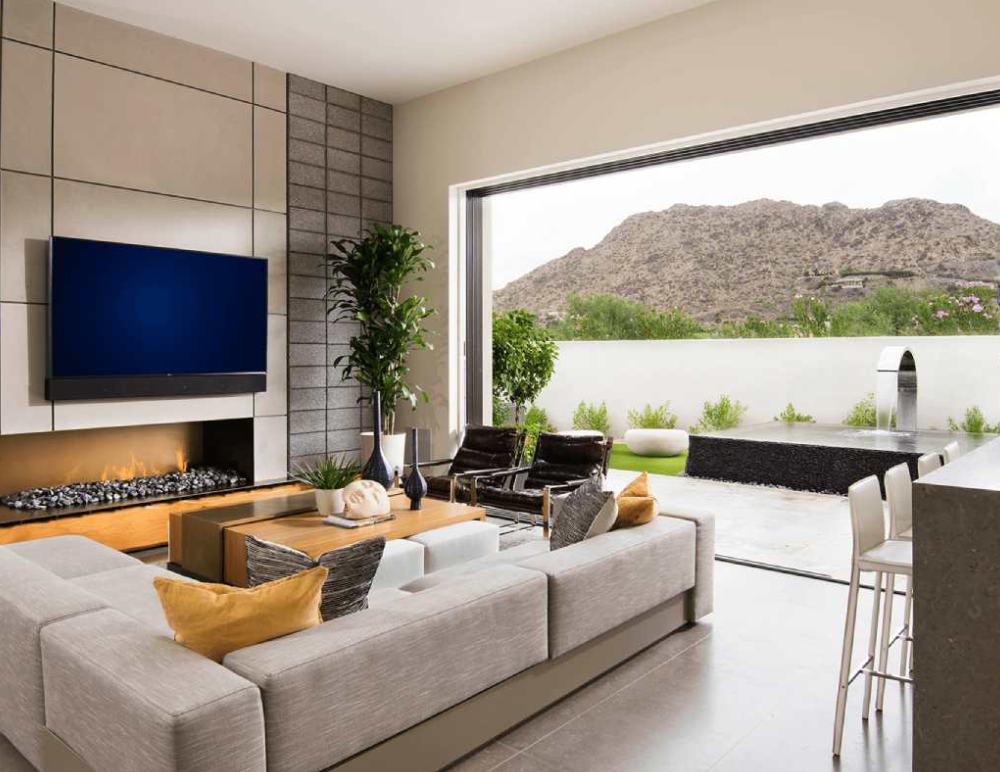Key Takeaways
- Texture combines tactile and visual elements to influence mood, depth, and character.
- Mixing types (soft, hard, natural, metallic) helps keep interiors rich and layered.
- Using contrast, layering, and deliberate focal textures strengthens spatial cohesion.
Texture in interior design often emerges as an unsung hero, subtly influencing a space’s ambiance and character.
As an experienced interior designer, I can attest to the profound impact that texture in interior design can have. Whether you’re an aspiring designer or a homeowner seeking a more luxurious living space, understanding the definition of texture in interior design and its myriad forms is crucial.
In this blog, we explore the significance of texture as an element of design and illustrate how the use of interior design textures can dramatically affect the atmosphere and functionality of a space.
Texture as an Element in Interior Design
Texture in interior design refers to the surface quality of materials and finishes used in a space, encompassing both tactile (how it feels) and visual (how it looks) elements. This duality of texture—how it interacts with light and how it can be physically experienced—plays a vital role in shaping the mood and functionality of a room.
Texture as an element of design is not merely about decor aesthetics; it also influences the perception of space. A well-considered textural strategy can enhance comfort, create visual interest, and contribute to a cohesive design narrative.
Creating Emotional Responses
Interior design textures have a profound impact on our emotions. Soft, plush textures like velvet or faux fur evoke feelings of comfort and luxury, making a space feel warm and inviting. On the other hand, sleek, hard textures like glass or metal can create a sense of sophistication and modernity. By mixing these textures, designers can craft a balanced emotional experience that aligns with the desired atmosphere of the room. Even stones can evoke different desired results. For example a polished granite can give a sense of solidarity and formalness like a bank lobby or a tumbled travertine can be warm and charming like a Tulum beach.
Enhancing Aesthetic Appeal
A well-designed room isn’t just functional; it’s also visually appealing. Textures play a key role in achieving this aesthetic appeal, adding layers and complexity to a design. This is especially true when incorporating office furniture designs into a home office or workspace, where sleek materials like wood, metal, or leather can elevate the room’s overall look. A thoughtfully designed space with a variety of textures invites exploration and curiosity, encouraging occupants to experience it more fully.
Adding Character and Personality
Every material has its own unique texture, which adds character to a space. A reclaimed wood table tells a different story than a sleek glass one. By thoughtfully incorporating different types of texture in interior design, designers can infuse a room with personality and charm, creating a space that feels uniquely tailored to the needs and lifestyle of its occupants.
Complementing Other Design Elements
Texture works hand-in-hand with other design elements like color, shape, and form. A bold, colorful wall can be tempered with soft, neutral textures, creating a balanced look. Similarly, a room with clean, geometric shapes can be softened with plush, organic textures. This interplay between texture and other design elements creates a harmonious and visually pleasing environment.
Types of Texture in Interior Design
Texture can be categorized into several types, each contributing uniquely to the overall design scheme. Here, we will explore some of the most impactful types of texture in interior design:
1. Soft Textures
Soft textures are known for their comfort and warmth. Fabrics like velvet, chenille, and cotton fall into this category. Soft textures are often used in upholstery, throw pillows, and rugs to create a cozy, welcoming environment. They are particularly effective in living rooms and bedrooms where comfort is a priority.
- Velvet: Known for its rich, luxurious feel, velvet adds a touch of elegance and sophistication. It’s perfect for statement pieces like armchairs or draperies.
- Chenille: This plush and soft fabric is ideal for creating a relaxed and inviting atmosphere. It is often used in sofas and cushions.
- Cotton: Cotton is a breathable, versatile fabric that is easy to maintain. It is a practical choice for various interior applications, from bedding to casual upholstery.
2. Textured Surfaces
Textured surfaces refer to materials with physical patterns or irregularities. You can add texture to surfaces by using techniques such as embossing, carving, or adding layered materials.
- Wood: Natural wood surfaces provide a warm, organic texture that can range from smooth and polished to rough and reclaimed. Wood adds character and a touch of nature to any space.
- Stone: Stone surfaces, including granite, marble, and slate, offer durability and a rugged texture. Their natural variations make them a popular choice for countertops, flooring, and feature walls.
- Concrete: Modern and industrial, concrete can be finished in various ways to create different textures, from smooth and sleek to rough and exposed. It’s a versatile material for contemporary designs.
3. Metallic Textures
Metallic textures can introduce a sense of glamour and sophistication to a space. Metals can be polished to a high shine or brushed to create a more muted effect.
- Brass and Gold: These metals add warmth and luxury, often used in fixtures, hardware, and decorative accents.
- Stainless Steel: Stainless steel is a material commonly used in kitchens and bathrooms to achieve a clean, modern, and contemporary look.
- Copper: With its warm, reddish hue, copper is a great choice for adding a unique, artistic touch to a space.
4. Natural Textures
Natural textures bring the essence of the outdoors inside, offering a sense of tranquility and connection with nature.
- Bamboo: Sustainable and stylish, bamboo adds a unique texture that works well in eco-friendly designs. It’s commonly used in flooring, blinds, and accent pieces.
- Rattan: This lightweight and versatile material is often used in furniture and decorative accessories. It adds a relaxed, tropical feel to the interiors.
5. Patterned Textures
Patterned interior design textures involve the use of patterns to create visual interest and depth. These can be found in wallpapers, wallpaper murals, fabrics, and decorative elements.
- Geometric Patterns: Clean, sharp lines and shapes can create a modern, structured look. Geometric patterns are often used in rugs, wallpapers, and textiles.
- Floral Patterns: Offering a more traditional or whimsical touch, floral patterns can add a sense of romance and elegance to a space.
Weaving Texture and Materiality Together
Materiality is the language of interior design. It’s the choice of materials that tell a room’s story, influencing its function, durability, and beauty. The right materials can elevate a space from ordinary to extraordinary, enhancing its narrative and enriching the user’s experience.

The magic happens when texture and materiality come together. This interplay transforms a space, creating depth and harmony that captivate the senses.
1. Creating Contrast
Contrast is a designer’s secret weapon. By pairing smooth surfaces with rough ones or combining soft textures with hard materials, you can craft spaces that are dynamic and intriguing. This contrast catches the eye and keeps the room from feeling monotonous.
2. Layering Textures
Layering textures in interior design is like composing a symphony. Each layer adds a new note, creating a rich, immersive experience. Imagine a living room with a smooth leather sofa, a rough stone fireplace, and soft woolen throws— juxtaposition of texture types adds depth and character to a space.
3. Crafting Focal Points
Focal points draw attention and create interest. A textured accent wall or a unique piece of furniture can become the centerpiece of a room, telling a story that captures the imagination.
4. Defining Zones and Functions
Textures can help delineate different areas within an open-plan space. For instance, a textured rug can define a seating area within a larger room, creating a sense of separation and organization.
5. Adding Character and Style
Texture is a powerful tool for conveying style and personality. Whether you’re aiming for a rustic farmhouse look with reclaimed wood and natural fibers or a sleek, modern vibe with polished metals and smooth surfaces, texture helps bring your vision to life.
Embrace Texture in Interior Design
Every element in a room contributes to its story. It doesn’t matter if you’re redesigning a traditional home or exploring park model home designs, texture plays a crucial role in achieving a cozy yet stylish atmosphere. By carefully selecting and combining materials, you can use texture to create spaces that are not only stunning and visually appealing but also deeply personal and inviting. Incorporating Contemporary Art into your design can further elevate the space, introducing a modern and artistic flair that speaks to your unique taste. From bold sculptures to abstract paintings, these pieces can become the focal point of a room, tying together textures and colors to create a cohesive and inspiring environment.
If you’re looking to transform your space and explore the possibilities of texture as an element of design, consider reaching out to IMI Design Studio. As an experienced interior designer in Scottsdale, Anita Lang is dedicated to helping you create a space that not only looks beautiful but also feels like home.
Contact us to schedule a consultation with an award-winning Arizona interior designer today!
FAQs
- Why is texture important in a room?
Texture adds depth, personality, and emotional warmth to a space. Without it, interiors can feel flat, sterile, or overly uniform.
- How do I combine textures without it feeling chaotic?
Start with a dominant texture and add one or two contrasting types to build interest. Keep your palette cohesive to maintain harmony.
- Can a space be too textured?
Yes, excessive texture can feel cluttered or overwhelming. Balance is key—use texture strategically with visual breathing room.
- How does texture interact with light?
Rough textures cast more shadows and highlight contrast, while smooth textures reflect light evenly. This can shift how a space feels depending on lighting.
- What’s a good first step to add texture at home?
Try layering a soft throw, patterned pillow, or textured rug. Small additions can significantly enhance comfort and visual richness.


